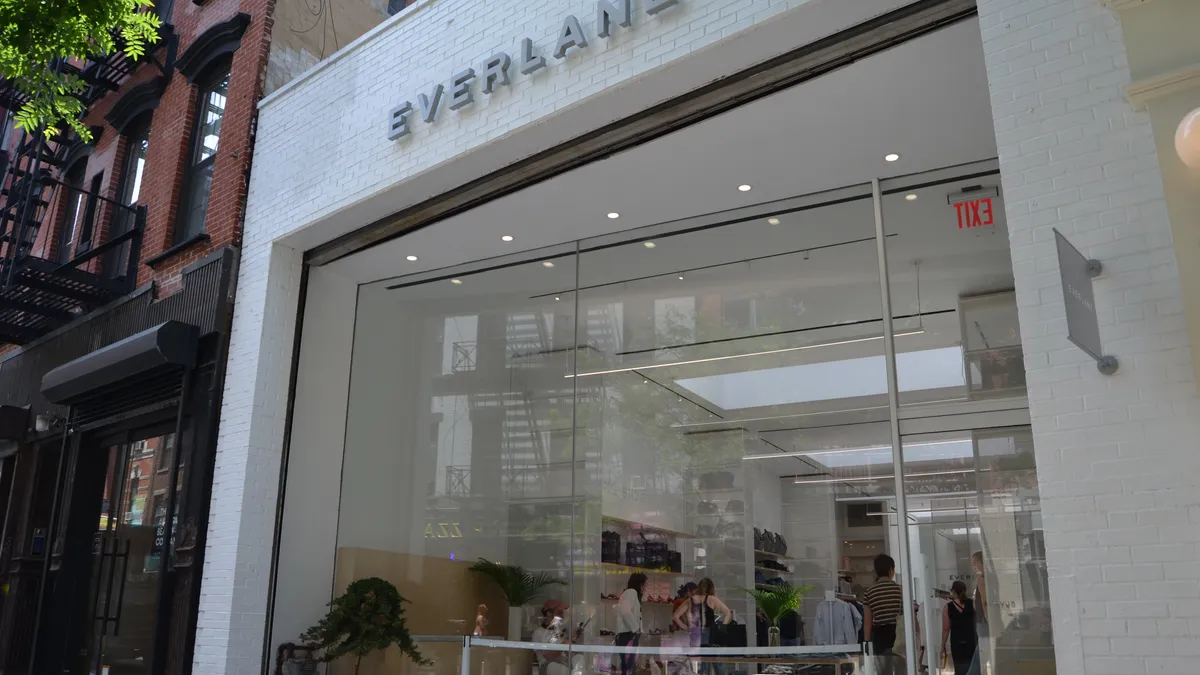In the past several weeks, over 100 retailers — both legacy and DTC — have temporarily shuttered their doors or reduced hours to help stop the spread of the coronavirus. For digitally native brands, which operate few stores relative to more traditional players, the move to operating exclusively online, in theory, should have come with little disruption to business. But that hasn't been the case.
Online spending at ThirdLove during the week of March 16 fell 39% week over week, while Poshmark fell 30% and StitchFix fell 9% during that same period, according to Edison Trends data shared with Retail Dive. As a whole, direct-to-consumer brand week-over-week spending fell 7% on average between March 2 and March 22. Comparatively, the average week-over-week increase for these brands from Jan. 6 to March 1 was 1%, according to the data.
DTC e-commerce is not unequivocally set up to succeed, said Andrea Szasz, a principal in the consumer practice at Kearney, in an interview. "Every time there is a bad announcement, or people get worried about their own well being and life and so forth, we see, [for] at least a few weeks, [a dip] in the consumption." And even when the numbers revert slightly, they are "nowhere close to the pre-crisis phase situation," she added.
While consumers are generally spending less across the industry when it comes to non-essential items, there's one thing that better positions some companies against the impacts of COVID-19 than others: how much cash they have available.
"There's high fixed costs associated with running stores for the occupancy as well as for the labor in the store. So it does position [direct-to-consumer brands] better than the omnichannel or brick-and-mortar retailers," Wedbush analyst Seth Basham said in an interview. "But a lot of these companies are not as financially stable. So their ability to weather the storm is still questionable."
"As a small business, we are absolutely feeling the impact of COVID-19."

Heidi Zak
Co-CEO, ThirdLove
These brands face other obstacles, like not being able to get additional funding right now or not having the necessary specialists working to help get them through this period. At the same time, some of these brands, like Wayfair, Chewy and Casper, were already dealing with unprofitability long before the coronavirus outbreak, though the latter has been able to narrow its losses slightly after its public debut.
Right now, DTC brands need to look where they can cut costs. "So if you have stores, push off your rent payments," Basham said, or brands may need to lay off or furlough employees in order to hold onto as much capital as possible. But the biggest area companies can cut from right now is advertising, Basham said. "It's a double edged sword, of course, because if you advertise less, you are likely to not drive as many sales. But since there's much less demand right now ... people aren't going to chase sales that don't exist."
Other than some retailers selling essentials — like grocery or general home items — there's no category that's "immune" from sales hits online. While in theory, it may make sense for consumers to invest in their homes (places they are spending the bulk of their time either by choice or government order), for example, rather than buying an apparel item, that's not likely the case for most Americans right now. A record 6.6 million people filed for unemployment benefits during the week ended March 28, according to the Labor Department. That was on top of the 3.3 million people who filed during the seven days prior to that.
People "who don't have disposable income are going to be much more hesitant to buy much of anything that's big ticket discretionary," Basham said. "So I don't think that we're going to see a net positive in the [home] category by any means in the near term."
What's next for DTCs?
This crisis may ultimately change the direct-to-consumer landscape, at least in part. Up until this point, many of these brands had been in expansion mode.
Casper announced in 2018 its plans to open 200 stores across North America, and reiterated those plans when it filed to go public earlier this year. Bedding brand Brooklinen opened its first permanent shop at the end of 2019, with intent to open "a lot of stores," and had already started scoping out locations.
The brands couldn't have predicted a global pandemic, and now they're likely to reassess any near-term goals. Direct-to-consumer lingerie brand ThirdLove, for one, announced in an Instagram post that it was permanently shuttering its New York City pop-up shop. "We are operating in unchartered territory with retail stores across the country closing, and at a time when virtually everything we hold as 'normal' is being challenged ... We had an amazing retail team who was hitting their stride, but our pop-up lease was up shortly so we decided to permanently close our only physical location," co-CEO Heidi Zak said in the post. "As a small business, we are absolutely feeling the impact of COVID-19."
Even retail giants are looking where they can make cuts right now. Nordstrom last week announced that it plans reductions of more than $500 million in capital expenditures, working capital and operating expenses. Similarly, Kohl's on Monday said it took steps to help mitigate the financial impact of the outbreak, including cutting about $500 million in capital expenditures; reducing marketing, technology and operations while stores are closed; and fully drawing down its $1 billion revolving credit facility.
And like many traditional retailers grappling with furloughing or laying off staff, DTC brands face similar decisions. Rent the Runway earlier this week confirmed to Retail Dive that it laid off all of its retail staff, providing affected employees with severance and two months of health insurance. The rental company announced mid-March that it was closing all of its retail stores. Everlane, which has also closed its stores indefinitely, has laid off 290 employees — 14% of which were part of the company's customer experience team — and offered two weeks of severance to those affected. An Everlane spokesperson confirmed to Retail Dive that the layoffs were, in part, a result of the company's revenue missing targets by 25%.
The coronavirus outbreak complicates decisions about brick and mortar, in part because some of the key tactics for fighting the disease — social distancing and stay at home orders — have a particularly pointed effect on stores.
"There's no reason to be opening stores that people can't go to, of course," Basham said. "And in an environment where we're trying to preserve capital, there's no reason to be signing leases and creating obligations."
"There's no reason to be opening stores that people can't go to."

Seth Basham
Analyst, Wedbush
There are a lot of uncertainties right now, particularly around the possible cyclical nature of the disease. If, for instance, the pandemic settled down over the summer, it's not yet known whether it could return in the fall when temperatures drop again.
"Until there is a global vaccine that will guarantee us that there's no comeback of the virus on a large scale, as we have it right now, I don't know if it is a successful strategy to think about jumping into brick and mortar," Szasz said. She noted that brick and mortar, in general, is not a bad strategy, but looking at how overstored the U.S. already is, she said there's a real possibility that many stores will permanently shut down depending on the length of the crisis.
Right now, brands may need to find solutions that give them the most flexibility in the event that the disease returns in the same way in a couple of months, Evan Bakker, a principal in the intelligence practice of Gartner for Marketers, said in an interview, adding that he expects there to be less of a commitment to expanding permanent shops now.
"It's about, 'How do I actually build out my e-commerce infrastructure to continue to be vital to my business and strong?' But then on the store side, 'How do I rethink my store strategy to be dynamic?'" Bakker said. "I think what that means for some brands with less stores is that potentially in the long term, you'll see more of an investment in pop-ups, short term, exclusive events — things that kind of drive loyalty and drive a lot of hype."
The pandemic may also lead to increased merger-and-acquisition activity. "The smaller firms on the market might struggle to raise money independently, and some companies that have deeper pockets might need to find new ways of engaging with the consumer and understanding how to become more nimble and more kind of customer focused," Szasz said
Depending on how long the pandemic persists and at what severity, she said, "there's probably going to be a lot of shaking out of direct-to-consumer brands, but also of retail brands."
Brand messaging is critical right now
Larger retailers like Walmart and Best Buy have an advantage in some ways because they already have strong omnichannel strategies in place, so operational adjustments aren't as big a hurdle.
But with smaller DTCs closing shops, it "actually means for them really doubling down on digital marketing in an effort to kind of convert on e-commerce purchases," Bakker said. In terms of advertising, he expects that to translate to mentions of free shipping and returns from these brands in order to drive purchases.
Analyzing 162 retailers and DTC brands with a brick-and-mortar footprint, Gartner found that the share of overall emails that mentioned either stores or fulfillment between March 1 and March 23 increased 4% from January and 8% from February. Many of those emails referenced store closures, updated operating hours and additional fulfillment methods, like curbside pickup or delivery.
A recent Gartner survey found that, already, 34% of marketers were altering their ad creatives as a result of the coronavirus, and 19% of them were starting to promote e-commerce offerings. "That was a really early sort of gut reaction," he said, adding that he expects those figures to go up in the coming weeks.
"Brands need to lead with information," Bakker said. "First, they need to acknowledge the situation, and then outline a clear action plan of what they're going to do to ensure safety."
However, now is the time for marketers to be thoughtful in their messaging and act with caution, Szasz said.
"Crisis moments are extremely emotional moments for consumers. Think of the fact that right now during the pandemic, there's a lot of extreme negative emotions that are going on through customers, the fear and the frustration and all those things," she said. "Then after the crisis ... there's going to be a lot of positive emotions of finally 'freedom.' This is exactly the time where you can build the best relationships with the customers based on trust."
"Crisis moments are extremely emotional moments for consumers."

Andrea Szasz,
Principal, Kearney Consumer Practice
It's important for a brand to be aware of how it portrays itself right now. Before the coronavirus outbreak, brands oftentimes needed to be provocative and shake consumers in order to stand out. The brands that aren't changing their approach during these times of uncertainty are the ones getting hit hardest, Szasz said.
In order to weather the storm, a brand has to create engagements that foster relationships with its consumers, Szasz said, which oftentimes means making "investments ahead of the ability to sell … These will be the brands that are going to be successful in picking up the volumes after the crisis."
It's "upper funnel" investments, Szasz said, which entail working to build that sense of community with their customers, rather than retargeting customers to try and drive immediate purchases. Platforms, Szasz said, work well at fostering this because it's "where customer engagements and commerce are much closer together. You can engage and build off the funnel relationship and basically, help the customer spend their time — because that's what the platform is — and at the same time have them buy, too."
Nike, which is using its experience in China as a "playbook" for navigating the coronavirus' impacts on its U.S. business, is turning to digital. The athletic brand last month eliminated the subscription fee for its NTC Premium service, which provides streaming workout videos, training programs and expert tips from trainers. It's a similar move to one Nike executed in China earlier, which CEO John Donahoe said drove sales through its commerce apps as a result of increased engagement, and led to 30% growth in its digital business in the region.
"I believe that companies that have platforms and places where consumers can have communities with each other ... are brands that can succeed," Szasz said. It's "where the consumers can really share how they feel, and the brands are listening. That's also a place where trust is built. That's very different than the one-direction brand marketing investment that many companies are doing, which is not what is needed right now."























